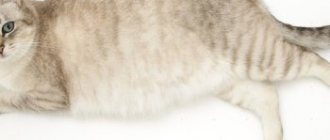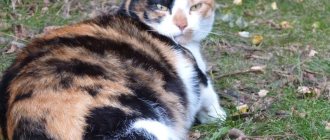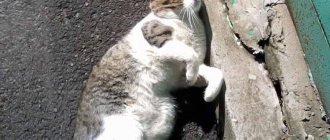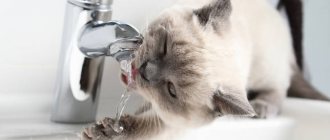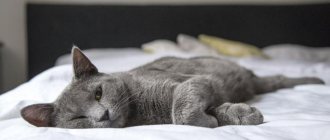Alopecia, or feline hair loss: what is it?
All cats shed twice a year, and this is the norm. How to distinguish: is it molting (the process when the fur is renewed) or pathology (baldness of the animal)? To do this, you need to know how the disease manifests itself, what its prerequisites are and in what cases the owner needs to sound the alarm.
Alopecia is the name given to abnormal hair loss in cats, as a result of which bald spots are formed on the animal's body - areas with absolutely no hair. The fur may fall out in clumps, forming bald areas on the animal's head, ears, and paws. Having noticed such areas, the owner should immediately take the pet to an appointment with a veterinarian. Baldness can be a signal of serious problems in the animal’s body.
But this should not be confused with hair loss, which normally occurs in all healthy felines. Cats lose their fur during:
- molting (a seasonal change of “coat” occurs twice a year; cats usually shed more than males);
- stress (the animal may shed some hair due to excitement);
- age-related changes (old animals lose hair and whiskers);
- frequent bathing (this is why it is recommended to bathe the animal only if necessary; twice a year is quite enough).
At the same time, the wool does not come out in clumps, without forming bald spots. But the disease has slightly different symptoms.
Part 2. Alopecia and skin pathologies in cats not associated with itching
Causes of alopecia (baldness) in cats and other skin diseases: read part 1: Skin diseases and alopecia in cats associated with itching
Causes of hair loss in cats
Alopecia is pathological hair loss, leading to its partial or complete disappearance in certain areas of the head or torso.
Alopecia
It can be diffuse, focal and localized. Diffuse – when hair falls out abundantly and all over the body, partial – when in several areas. Localized - when only one area is affected.
Self-induced
or
self-induced alopecia
is when the animal itself licks or tears out its fur.
Spontaneous alopecia
– when the hair falls out on its own.
Hypotrichosis
- (from the Greek hypo - reduction, trich - hair) is a disease that is characterized by a partial absence of hair.
In this part we will look at alopecia and pathologies of the skin and hair that are not associated with itching.
Alopecia associated with cat breed.
Some cat breeds may have alopecia and pathologies that are unique to them. This is usually due to genetic characteristics when breeding the breed. This should be taken into account when making a diagnosis.
Sphynxes and other hairless breeds
They have the “baldness” gene artificially fixed. In fact, this is a fixed mutation (dysplasia) of underdevelopment of the follicle. But in nature, everything tends to be normal, so sometimes their follicles can still produce hair, but it turns out to be small, often twisted, and does not always come to the surface, causing clogging of pores with keratin, keratinized epithelium, causing comedones or other disorders of the hair follicle.
In half-naked cat breeds
Rex, Devon Rex - there may be less hair on the chest and ventral surfaces of the body and this is normal. They are often unevenly coated and may also shed unevenly.
Blue and beige Cornish and Devon Rex cats have follicular dysplasia, which is a disorder of pigmentation in the follicle. In the follicle matrix, cells produce melanin. If the formation of melanin is disrupted, it is produced in clumps, which leads to hypotrichosis of these hairs. The skin looks healthy, but at a young age they begin to go bald.
There is a breed of cats, the Likoi, which have no hair at all on their faces according to their breed.
Abyssinian cats have a pathology of the hair shaft, integumentary hairs and vibrissae, in which the tip of the hair swells like a bulb, resulting in the coat having a dull, unpresentable appearance and hard to the touch. Fortunately, it is rare.
There is an anomaly called pili-torti, in which the hair shaft gets twisted and it falls out. It begins within a few weeks and is accompanied by extensive alopecia.
Hairless kittens can be born to absolutely healthy parents (Burmese and others), that is, a spontaneous mutation can suddenly occur. Such animals should absolutely not breed to prevent them from becoming established in the breed.
Alopecia symptoms
You can recognize alopecia in a pet by the following signs:
- The fur falls out excessively, in clumps. Bald spots in cats appear mainly behind the ear, in the neck, back, and on the tail.
- The skin in these places may have its usual pink color or turn red, sores or scabs may appear there.
- Check your pet's reaction to touching the bald spot: perhaps the spot hurts or itches.
- Check if the animal has symmetrical bald spots.
If you notice these symptoms, you should urgently seek professional help from a veterinarian. Otherwise the disease will progress.
Causes of this disease
If an animal has bald spots on its body and head, this may be a sign of a food allergy. Allergies should be looked for in your pet's diet. They can be:
- Proteins of animal and plant origin;
- Various cereals;
- Meat – in particular lamb.
In addition, it may be an allergic reaction to flea bites, cigarette smoke or other odors (inhalation allergy).
The causes of baldness may lie in the psychological state of the pet, that is, hair may fall out due to stress. If the veterinarian diagnoses this reason, then the first thing the owner needs to do is find out what kind of stress or experience the pet has had recently, eliminate it, and only after that give sedatives, which only in this case will be effective. Symptoms of alopecia of a psychogenic nature are bald patches that are located on the thighs, abdomen or paws.
The causes belonging to the third group are infectious. If a cat's hair is falling out, the culprit may be scabies, lichen, fungus, or mites. If a cat has a bald spot behind its ear, it could be ringworm. There are several varieties: fungal (another name is ringworm; contagious to humans), psoriasis or eczema, viral.
Hair mites can also cause hair loss. They are very small and impossible to notice with the naked eye. Lice eaters do not live long, but they reproduce very quickly.
If your cat has bald spots on its neck, the cause may be dermatitis. It can be caused by various chemical and biological factors. Even treatment for parasites can cause hair loss.
Hair loss can be a consequence of seborrhea, a disease in which the functioning of the sebaceous glands is disrupted. This is usually indicated by baldness in a cat near the tail. That is why this disease is sometimes called “greasy tail”.
Another group of problems that cause baldness is disruption of the hormonal system:
- thyroid problems, manifested by both increased and insufficient levels of hormone production;
- diabetes;
- malfunctions of the adrenal glands, in particular their hyperfunction.
Other reasons include the presence of tumors in the animal, genetic predisposition and reactions to medications. Thus, a kitten’s bald spot may appear due to the fact that during pregnancy its mother did not receive various essential minerals and vitamins.
Pathological causes of baldness
All hair loss that occurs for pathological reasons requires specific treatment. The therapeutic strategy is aimed at eliminating the cause of the disease and eliminating symptoms.
Lichen
This is a group of diseases accompanied by the appearance of skin rashes, scales or nodules, and hair loss. Cats with weakened immune systems become ill. Fungal infections are combined with bacterial infections and occur mainly against the background of the underlying pathology
Parasitic factors
Small ectoparasites - lice eaters - feed on the skin along the edges of its microscopic defects - scratches, ulcers. But the main component of their diet is wool. The cat is going bald.
The activity of subcutaneous mites is accompanied by the development of dermatitis, inflammation of the hair follicles, and hair loss. There are demodicosis, notoedrosis, and sarcoptic mange.
Ringworm in a kitten
Allergy
Hypersensitive reactions, accompanied by dermatitis with hair loss, develop to insect saliva, household items, food components, accessories and inhaled irritants.
Imbalanced diet
An important role is played by the ratio of lipids, carbohydrates and protein in a hundred-kilocalorie portion, as well as the saturation of the diet with vitamins. It is known that the condition of the coat depends on the amount and ratio of biological catalysts in the incoming feed. Hair loss is caused by deficiency or excess of vitamins.
The desire to do what is best plays a cruel joke on cat owners. Most vitamins can accumulate in the body's depots. Primarily in adipose tissue and liver. Uncontrolled feeding of a pet with food additives leads to oversaturation of organs and textures with active compounds. There is a perversion of metabolism, toxicosis, baldness and more serious consequences.
To avoid vitamin poisoning, it is necessary to select factory-prepared food in consultation with a veterinarian. The most nutritious food mixture is intended for a lactating cat. But after the end of the feeding period, you need to return to your normal diet.
Hormonal disorders
When the endocrine glands do not function properly, hormonal imbalance occurs, accompanied by hair loss. Seborrhea develops and pigmentation is disrupted. Black dots appear on the skin - acne.
Physical and chemical factors
When a cat's skin is not properly treated against external or intradermal parasites, a chemical burn occurs, accompanied by hair loss. Solar radiation and contact with hot radiators cause inflammation of the sebaceous glands and hair follicles, accompanied by hair loss.
Acne on the tail of a sphinx
Congenital pathologies
Seborrhea is a pathology of the sebaceous glands that causes excess secretion. The disease is accompanied by itching, dermatitis, and necrosis of hair follicles. The condition, called sebaceous tail, causes clogged pores and hair loss on the back and ends. There are congenital seborrhea and acquired as a result of parasitic influence.
A similar hereditary disease is called adenitis, which occurs in young and older cats.
Hypotrichosis is a genetic disease in which kittens are born with sparse hair and become completely bald by 4 months. A cat that has lost its natural clothes is doomed to constantly freeze and needs artificial ones.
Greasy tail
Chronic intoxication
Accumulating toxins enter the fur. The body gets rid of toxic products by shedding hair. This is a defensive self-purification reaction.
Diagnosis of the disease
If a cat's hair falls out in clumps before bald spots form, it should definitely be seen by a specialist. Only a veterinarian can accurately determine the diagnosis. To determine the disease and prescribe the correct treatment, the doctor must:
- Find out how and when the disease manifested itself. The owner will have to tell in great detail the animal’s lifestyle, what the pet ate and drank, what it came into contact with, and whether it walked outside.
- Examine the patient.
- Examine hair roots under a microscope.
- You may need blood and hormone test data, and a scraping will be required.
- Sometimes an ultrasound or x-ray is done to confirm or rule out the presence of tumors.
Treatment of hair loss in cats
Hair loss in cats is a serious but completely treatable disease. Treatment must be selected individually. What medications the doctor will prescribe depends on the causes of the disease. If bald spots on the ears or other places appear due to allergies, the animal must first be isolated from the allergen. The doctor also prescribes drugs that stimulate the immune system and antiallergic medications. If there is a food allergy, you should review the animal’s diet and switch it to hypoallergenic foods.
If the cause of an animal's hair loss is parasites, the pet is treated with gel and ointment that have antiparasitic properties. In such cases, it is also recommended to give the pet drugs that stimulate the immune system.
If the bald spots were caused by an abscess, the animal must undergo a course of treatment with antibiotics and antiseptics. If a cat has been diagnosed with endocrine problems, she is prescribed hormonal medications.
Preventive measures
To prevent ear baldness in cats and hair loss on other parts of the body, it is recommended to take preventive measures in advance. Namely:
- regularly independently examine the animal, take it for professional examinations, and, if necessary, for treatment at the veterinarian;
- vaccinate your pet on time;
- do not forget about proper hygienic care of the cat;
- Provide your pet with proper nutrition.
Bald spots in cats on the head, ears, belly or paws are a fairly common phenomenon. Why a cat has bald spots on its back or other parts of its body - only a doctor can say for sure after conducting the appropriate diagnosis. Depending on this, treatment is prescribed, which can consist only of diet, or contain a course of hormonal drugs or antibiotics. But it is highly not recommended to self-medicate your pet: you can only torture the animal with unnecessary drugs, and in the meantime the cat will lose most of its fur coat.
Bald spots at first glance seem harmless, although they spoil the aesthetic appearance of the animal. But it should be understood that they can be provoked by quite serious diseases that develop in a pet. Therefore, you should not hesitate to visit the doctor.
Causes of hair loss in cats
Cats need fur to protect them from damage. Seasonal molting is explained by the need to adapt to the surrounding temperature. Therefore, for example, sphinxes that do not have a thick undercoat (the opinion that they have no hair at all is deeply mistaken) easily get wounds and scratches.
A cat's fur is her pride, although we, the owners, are even more proud of it. Smooth and shiny fur is an indicator of the animal’s good health, so it is not surprising that its dullness and loss makes you want to understand the reasons.
Shedding
Seasonal shedding in cats is a natural phenomenon. In the fall, your pet “changes” its fur, changing it from summer to winter. At this time, the undercoat becomes thicker, while in the spring, on the contrary, it thins out.
We also recommend reading the article about why cats shed.
The beginning of the process can also be judged by your own clothes. As soon as a cat walks near you, your trousers or dresses become covered with hair. When shedding in long-haired animals, the hair may fall out not in individual hairs, but in clumps. In order not to pick it up from upholstered furniture and clothing, it is advisable to purchase a steel comb for the fur and a bristle brush for the undercoat at the pet store. Recently, special gloves for combing have become popular: cats do not react to them as aggressively as to combs, and they are convenient for removing dead hair.
During the molting period, cats begin to actively lick themselves. Fur from the tongue gets into the stomach, accumulates there, and does not always come out naturally. To avoid problems, it is advisable to give your cat special medications (vitamins, pastes) that help remove lumps from the stomach. Special fat additives containing concentrated fatty acids can be added to the feed in spring and autumn.
Poor nutrition, lack of vitamins and minerals in the diet
If your pet suddenly begins to actively shed, or bald spots appear on its body, you should reconsider its diet. Cheap food, despite active advertising, does not contain all the necessary vitamins and minerals, so it is necessary to change it to more nutritious ones - premium and super premium class, holistic, and add vitamin complexes. Once a week, it is recommended to give your cat a raw chicken egg with food and grow cat grass. Seeds or sprouted greens can be purchased at a pet store.
Vitamins that are good for a beautiful coat:
- biotin (vitamin H);
- taurine
In addition to improving the condition of the skin and coat, they have a beneficial effect on the functioning of the cat’s vital organs: the heart and blood vessels, stomach, etc.
Allergy
One of the most likely causes of excess hair loss in cats is allergies. Its symptoms may be:
- skin redness;
- itching (the cat actively scratches itself);
- eczema and blisters;
- otitis;
- nasal discharge;
- diarrhea or vomiting.
You can observe the manifestation of only some symptoms or a whole complex of them. The most common types of allergies:
- food;
- reaction to flea saliva;
- atopic dermatitis (to substances present in the external environment, air).
It is impossible to determine its presence in an animal on your own, so if you observe symptoms indicating a possible pathology, your pet should be shown to a veterinarian. He will take tests, determine the allergen and prescribe treatment.
Skin parasites, mites
Outdoor and free-ranging cats run the risk of harboring mites on their bodies, which cause scabies. The disease is accompanied by severe skin irritation and itching, and hair loss.
There are several types of mites that parasitize the body of cats: some prefer to settle in the auricle, others infect the skin around the eyes, head, and neck. As they make passages under the skin, they cause severe itching and leave traces of vital activity that gradually poison the animal’s body. Without treatment, the pet may die.
Ticks on a cat
To prevent insect damage, it is important to treat animals regularly, every three months, even if they do not leave the apartment. People can carry fleas and ticks on their clothes and shoes.
Only a veterinarian can identify the causative agent of the disease by taking a scraping from the animal’s skin and determining the type of parasite. Treatment will depend on this.
Lichen
Dermatophytosis (lichen) in cats is a dangerous infectious disease. Its causative agents are mold fungi, which first affect the skin, then the fur and claws. The disease, which may not manifest itself for a long time, often affects weakened, injured animals.
The animal owner may also notice signs of the disease that require urgent action:
- hair loss;
- itching;
- the appearance of round bald spots;
- excessive shedding;
- uneven, deformed claws.
During the treatment of an animal, a person needs to be careful, since the disease is dangerous for him too.
Hormonal imbalance
Brittle, dry and lifeless fur in a cat is a sign of hormonal disorders. The reasons may be different: the postpartum period, lack of thyroid hormones in the blood, and others. Endocrine disorders may be indicated by symmetrical loss of fur on both sides.
You will need to be examined by a veterinarian and take medications prescribed by him to restore hormonal levels.
Solar dermatosis
Cats can also get sunstroke. Burned skin is called solar dermatitis, the danger of which is the possible development of squamous cell carcinoma (skin). White pets are more often susceptible to it, since their fur does not contain melamine (color pigment), which protects from the sun.
The disease is expressed by redness of the skin, loss of hair, and the appearance of scales on the affected areas that cause itching. There is no pain syndrome, but the crusted area of the body looks irritated and vulnerable. The dermatosis will develop further and ulcers will appear.
The disease is treated with antibiotics and special creams. It is necessary to minimize the animal's exposure to the sun as much as possible.
Folliculitis
This is an inflammation that occurs in the hair follicles as a result of insufficient care of the animal. The causative agents of the disease are bacteria, fungi or viruses. Pets with weak immunity, metabolic disorders, and hypovitaminosis are most often affected.
Consequences of other diseases
Hair loss can be caused by other diseases in the animal's body. For example, granulomas. It occurs as a reaction of the body to the suture thread. Development is possible after surgical interventions: bald patches and ulcers appear on the cat’s body.
Alopecia (baldness) can be caused in a cat by:
- thyroid diseases;
- A-hypovitaminosis;
To determine the cause of baldness, you need to take your pet to a veterinarian as soon as possible.
Hair loss at the injection site
After subcutaneous administration of certain drugs (antibiotics, rabies vaccine, progesterone, praziquantel, glucocorticoids), cats may experience baldness. As a rule, it passes quickly, and the injection site is overgrown with hair, however, sometimes this process drags on for a long time, and a small bald spot can be observed on the animal’s skin.
What does a bald spot look like at the injection site?
Stress and nervous tension
Domestic cats often suffer from stress, which can result in increased shedding. There are different reasons:
- long absence of the owner;
- the arrival of a new family member or a new pet in the house;
- change of house and others.
Cats have a hard time with separation, lack of attention, and can even become depressed. As a result, the fur loses its attractiveness, the wool becomes dull and falls out. A little attention and affection, love and care is the best cure for stress.
Autoimmune diseases
Otherwise - nesting baldness, which leads to hair loss in clumps, most often in the head and neck area. Autoimmune diseases are rare in cats, but require attention and treatment.
Dandruff
Yes, domestic cats are also susceptible to seborrhea. The cause is the improper functioning of the sebaceous glands. With dry seborrhea, the skin peels off, small scales appear, popularly called dandruff.
The second type of disease is oily skin, which produces excess sebum. The wool sticks together, gets greasy, becomes sticky and falls out in clumps.
Appearance of dandruff in a cat

